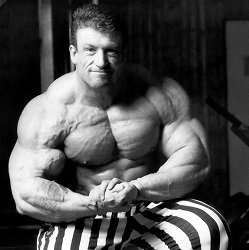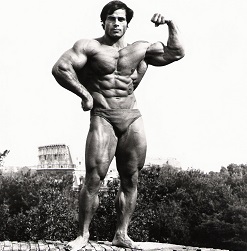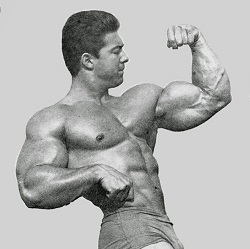Home / Workouts & Reviews / The Ultimate 3 Day Split Workout Routine For Building Mass (Beginner’s Guide)
The Ultimate 3 Day Split Workout Routine For Building Mass (Beginner’s Guide)
07/08/2020share
tweet
share

The Ultimate 3 Day Split Workout Routine For Building Mass (Beginner’s Guide)
Nowadays:
It’s not uncommon to browse forums on the internet and be flooded by anecdotal advice from faceless gravatars telling you the best way to get jacked/ripped/swole and so forth.
The problem?
The information typically comes from clueless, humbug cowboys who are either looking to sell you something, or have passed on some broscience where their own lifting experience is questionable.
This is usually why such threads are littered with prescriptions of programs that call-out six workouts (lasting at least 2 hours each) every single week.
Every now and then,
Someone will even go as far as suggesting training TWICE per day.
Seriously, who has time for that?
However:
In this post, we’ll look at a 3 day split workout routine for building mass which involves stripping back your training time to last no longer than an hour.
The idea is to get in the gym, put in some work and get the fuck out and back to reality all with a plan in hand.
Sound good?
Let’s get into it.
What is a 3 Day Split Workout?
A 3 day split workout is a weight training program that requires you to train specific muscle groups on 3 non-consecutive days of the week.
In other words:
Rather than train your fully body on a given day, you’ll only focus on one or two major muscle groups each day.
A typical 3 day split might look like the following:
Training Split 1
- Sunday – Rest
- Monday – Back, Biceps and Abs
- Tuesday – Rest
- Wednesday – Chest, Triceps, Traps
- Thursday – Rest
- Friday – Legs and Shoulders
- Saturday – Rest
Or…
Training Split 2
- Sunday – Rest
- Monday – Rest
- Tuesday – Back, Biceps and Abs
- Wednesday – Rest
- Thursday – Chest, Triceps, Traps
- Friday – Rest
- Saturday – Legs and Shoulders
Having your training routine split out into 3 non-consecutive days enables you to place greater focus and intensity on a specific muscle group, whilst giving them extra days to recover before being worked again.
All-in-all,
A 3 day split workout routine gives you the intensity and flexibility you need to build muscle mass without compromising on life outside of the gym.
Why is a 3 Day Split Workout Routine Good for Building Mass?
 Having a 3 day split workout routine is great for building mass because you are giving your muscles enough time to recover and rebuild after being trained.
Having a 3 day split workout routine is great for building mass because you are giving your muscles enough time to recover and rebuild after being trained.
This give your body the opportunity to release and regulate growth hormones for muscle recovery without being compromised from continual stimuli in an optimal recovery window.
When just getting started, a common mistake a lot of beginners make is the belief that ‘more is better’.
However,
From a physiological perspective, this is not the most practical route to go down.
Why?
Your body is controlled by the central nervous system (CNS) which is made up of the brain and spinal cord.
Both of these are designed to give you freedom of movement, but exercising more than you need to can fatigue the central nervous system to the point of inefficiency in the long-run.
Training too frequently and intensely without prioritising recovery means that stress hormones (like cortisol) will continually be released by the body.
This is counter-productive for muscle performance and will hinder, rather than promote, muscular growth.
So, by having a 3 day split, you give your targeted muscle(s) at least 6 days rest before being hit again which is ample time for your body to repair damaged tissue.
A 3 day split also allows you to focus more intensely on the worked muscle(s).
As you won’t be pressured into exercising every single muscle group, you can spend more time targeting a specific group of muscles instead.
This allows you to fatigue the muscle(s) a lot more effectively through heavier loads or more sets/exercises which can lead to better results for building muscle.
The Ultimate 3 Day Split Workout Routine for Mass
Before we dive into the training program, here’s a summary of the goals and objectives of the 3 day split workout routine:
- Main Goal: Build Muscle
- Type of Workout: Split
- Training Level: Beginner
- Training Duration: 8 Weeks
- Number of Training/Rest Days: 3 Training Days/4 Rest Days
- Time Per Workout: 1 hour
As the goal is to build muscle whilst keeping the time spent in the gym to a minimum, greater focus will be placed on compound exercises. This is to ensure you’re targeting multiple muscle groups at once.
Not only will compound lifts help promote greater growth hormone release for hypertrophy, but they’ll also work secondary muscles a lot more frequently for all-round muscular balance.
Workout 1: Back, Biceps and Abs
| Exercise | Sets | Reps |
|---|---|---|
| Barbell Bent Over Rows | 4 | 10 – 12 |
| Lat Pulldowns* | 3 | 10 – 12 |
| Seated Cable Rows | 3 | 10 – 12 |
| Barbell Curls | 4 | 10 – 12 |
| Seated Incline Hammer Curls | 3 | 10 – 12 |
| Leg Raises | 3/4 | 15 – 25 |
* The first 2 – 3 weeks should be used to build the strength to progress to doing pull ups. In weeks 4 – 5, you should be transitioning to assisted pull ups with weeks 6 – 8 progressing onto unassisted pull ups.
Workout 2: Chest, Triceps and Traps
| Exercise | Sets | Reps |
|---|---|---|
| Barbell Bench Press | 4 | 10 – 12 |
| Dumbbell Flyes | 3 | 10 – 12 |
| Dumbbell Pullovers | 3 | 8 – 10 |
| Skullcrushers | 3 | 10 – 12 |
| Tricep Rope Pushdowns | 3 | 10 – 12 |
| Upright Rows | 3/4 | 10 – 12 |
Workout 3: Legs and Shoulders
| Exercise | Sets | Reps |
|---|---|---|
| Barbell Squats | 4 | 8 – 12 |
| Romanian Deadlifts | 3 | 8 – 10 |
| Leg Press | 3 | 8 – 10 |
| Arnold Press | 4 | 10 – 12 |
| Standing Dumbbell Side Lateral Raise | 3 | 10 – 12 |
| Seated Dumbbell Rear Delt Flyes | 3 | 10 – 12 |
Examination
For every major muscle group such as your chest, back and legs, during the 3 day split workout, each group will be targeted by at least 2 compound-based exercises at the beginning of each workout.
As a beginner starting out, performing compound exercises will be at the foundation from which you will build your strength and mass.
You’ll simply spend too long in the gym if you were performing isolation (single-joint) exercises on their own which only work to complement your physique by correcting muscular imbalances.
Not only this:
Performing compound movements at the start of your workout will ensure you’ve pre-exhausted your secondary muscles such as your triceps and biceps, which will allow you to benefit from increased hypertrophy.
When you move on to the more ‘isolation-based’ exercises during the 3 day split workout routine, such as seated incline hammer curls and tricep rope pushdowns, you’ll create even more micro-tears in your muscle fibers – prompting greater growth potential on your recovery days.
When it comes to weight selection, you want to select a weight you’re comfortable with. One that will allow you to perform at least 12 reps with great technique.
If you can’t perform 12 reps with good form, it’s likely you’re lifting too heavy and will need to drop the weight down.
Selecting the right weight for you (enough to challenge your muscles whilst maintaining posture) is critical in getting the most out of this, and any workout for that matter.
Whilst the 3 day split workout routine for mass contains a lot of volume (you will be performing 20 sets of exercises during each workout, afterall), it’s important to note that there are various ways you can manipulate each workout to fit into your lifestyle that will still produce excellent results.
This will be covered in the ‘progressive overload’ section shortly.
However,
When you are just starting out, high volume training is key in building significant muscle mass, as your body will need to adapt to the stress it is being placed under very quickly.
Therefore:
Do not fear performing a lot of volume (i.e. sets x reps x load), as this will help you pack on mass in little to no time.
Notes
Cycle
In an ideal world, you’ll want to be structuring your workout around Training Split 1 mentioned earlier.
This will ensure you get some social life in on the weekend.
There’s nothing worse than feeling like you have to hit the gym over the weekend (unless of course, you’re single) and missing out on getting absolutely butchered down your local or just generally having a good time.

When you’re just starting out, training at the gym should be something you look forward to which shouldn’t feel like a slog.
The main thing is:
You are fitting it around your lifestyle, not the other way round.
The 3 day split training program should be performed for a minimum of 8 weeks as this will give you enough time to reap the full benefits of performing each exercise consecutively for maximum hypertrophy.
If you’re also looking to burn a bit more fat, consider other activities that put less of a strain on your body during your recovery days such as walking or swimming.
Again, balance is key.
You want to give your body enough time to rest and recover for the next session so don’t let your training dominate your life.
Duration
The time at which each workout is completed will pretty much vary depending on how quickly you can recover between sets.
As a general rule of thumb, the 3 day split should last no longer than an hour.
In between sets, you want to be resting for a minimum of 45 seconds and 1 minute maximum.
Of course:
It’s important to listen to your body.
If you feel like you need to take a few extra seconds to get your bearings about you, then take it.
But by no means should you be mindlessly scrolling on your phone sliding creepily into someone else’s DMs – you’ll only waste time and lose focus.

Progressive Overload
In order to get the most out of this routine and to avoid hitting plateaus, you want to be incorporating progressive overload.
This means that you should be gradually increasing the level of stress and/or intensity placed on the muscles in order to make them grow.
A few simple strategies you can employ to progressively overload your muscles are:
- Adding weight
- Adding reps at same weight
- Adding sets
- Decreasing rest time between sets
All of these are pretty self-explanatory, but to give you an example of what this might look like in practical terms, below are a few considerations:
Strategy 1:
- Week 1: 35kg x 10
- Week 2: 37.5kg x 10
- Week 3: 40kg x 10
Strategy 2:
- Week 1: 3 x 10
- Week 2: 3 x 11
- Week 3: 3 x 12
Strategy 3:
- Weeks 1 – 4: 3 sets
- Weeks 4 – 8: 4 sets
Strategy 4:
- Week 1: 1 minute
- Week 2: 55 seconds
- Week 3: 50 seconds
You can include any of these strategies in your training, but ideally you should focus on just one at a time.
For the purposes of building mass, I would recommend using Strategy 1.
This will ensure you are building up size and strength over time, keeping yourself challenged and avoiding a plateau.
As you’ll still be performing exercises in the 8 – 12 rep range, you should still be able to keep your gym time to a minimum.
In terms of how much weight you should be adding to the bar each week, 2.5kg is enough to push the boundaries whilst still maintaining correct posture and form.
 However,
However,
If you’re not comfortable with adding weight to the bar every week, you can explore keeping your weight selection moderately heavy (enough to achieve 12 reps) and employing Strategy 3 or 4.
Either way:
The key thing is you are increasing the stress placed on your muscles for growth, so employ whatever works for you.
Rest-Pause Training
At some point, you’ll likely be unable to complete your full set of reps (provided you are progressively overloading).
Incorporating rest-pause training is one of the most effective ways to combat this whilst giving you the ability to effectively train for hypertophy.
How does it work?
Rest-pause training involves working at maximum intensity on a given set and once you reach a point where you’re unable to complete your full set of repetitions (e.g. you can only do 8 repetitions consecutively), you then take a break for a few seconds to catch your breath.
You’ll then continue with your set forcing out the extra repetitions until you have fully completed your desired number of repetitions.
Why is this effective?
Rather than continuing the exercise (past the point of failure) with poor technique, you allow your body enough time to recover to return to the exercise and squeeze out those additional reps with better form.
And in case you didn’t know, good form is one of the fundamentals of getting excellent results in building mass.
Therefore, rest-pause training will ensure any form of ‘sloppiness’ is removed from your training, giving you a better outcome.
However:
When you incorporate rest-pause training, it is important to rest for only a few seconds (such as between 10 – 15 seconds)
Resting any longer can help the fatigued muscle tissue quickly recover rather than stimulating new and untapped fibres from being employed, which will limit your overall progress from this training method.
Nutrition
 One of the most important tools on your quest to build muscle mass is proper nutrition.
One of the most important tools on your quest to build muscle mass is proper nutrition.
You can follow the best training plan to suit your needs, but without an adequate eating regime, it will all be a waste time if your body is not getting the sufficient amount of fuel (in the right quality/quantities) in order to grow.
There are three main macronutrients you need to understand when it comes to nutrition as these should form the basis of all of your meals:
Why macronutrients are important
- Protein – essential for muscle repair and growth and also an important building block of bones, cartilage and skin (4 calories per gram).
- Fat – essential for cell growth, hormone production and can be used as an energy source (9 calories per gram)
- Carbohydrates – the bodies main energy source which helps to fuel your organs and central nervous system (4 calories per gram)
Ensuring you’re getting enough protein in your diet is a key component of building muscle as protein forms the foundation of many structural changes in muscle tissue.
Most fitness experts recommend that you consume at least 2g of protein per kg of body weight per day (with 1g being the bare minimum) for the purposes of building muscle.
So if you weigh 80kg for instance, you want to ensure you’re eating 160g of protein per day.
Fats play an important role in hormone production (such as testosterone), so having a diet low in fat can inhibit your ability to maximise muscle-building potential.
Ideally, fats should make roughly 20 – 30% of your daily calorie allowance (0.5 – 1g per kg of body weight is a good estimate).
Although non-essential, carbohydrates are easily broken down by the body to form sugar glucose. It is then absorbed into the bloodstream and with the secretion of a hormone called insulin, travels into the body’s cells as a form of energy.
Carbs should make up the rest of your macronutrient profile once you’ve factored in protein and fats.
Working out your calories
Now that you have a better understanding of the main macronutrients, in order to make the most out of this training program, you need to figure out what your calorie level looks like in order to maintain your current size.
You should then aim to eat in a slight surplus above this (for instance an extra 200 – 300 calories a day) to ensure you’re giving yourself the best chance of building maximal muscle.
Checkout this tool which will work out your maintenance calories, where you can then add more calories on top.
What ever meal plan you decide to use, it has to be specific to your goals and easy enough for you to sustain to meet your lifestyle requirements.
 Therefore:
Therefore:
A prescriptive plan won’t work for everyone.
Rather than give you a list of foods to eat (which you can easily Google), it would be far more beneficial to give you a breakdown of calories that you can put towards the foods of your choice.
Again – the aim is to make everything as sustainable as possible so you can stick with it.
Ultimately:
You have the choice to eat more or less frequently, or with greater volume at each meal (provided you are getting your surplus calories in with sufficient amount of protein).
Below is an example of a calorie plan for a male who weighs 80kg with a 9-5 desk job, who is looking to train between 1 – 3x a week to gain muscle.
Maintenance Calories – 2,482kcal/day
Surplus Calories for Muscle Mass – 2,782kcal/day
- Protein (2g/kg) – 160g (640 calories) / 23% of total macros
- Fat (0.75g/kg) – 60g (540 calories) / 19% of total macros
- Carbohydrates – 382g (1,602 calories) / 58% of total macros
The main thing is to keep your nutrition simple, relying on whole-based foods and plenty of fruit and vegetables.
By tracking your total calorie and protein consumption daily, over time, everything will begin to fall into place.
As you begin to build up better awareness of the foods you eat, you’ll be well on your way to putting on more size.
Bringing it all together
Following a 3 day split workout routine is one of the most convenient and effective ways to build muscle mass.
Not only are you including a mix of compound and isolation-based exercises, but there is ample recovery time included throughout the week which is often overlooked (even by most advanced lifters).
Often you’ll find that it is a lot easier to build muscle in the early weeks of the program as your body adjusts to the new stress it is being placed under, but over time, it’ll quickly adjust to the stimulus.
It is important that you keep progressively overloading and challenging your muscles throughout this training program to ensure you don’t hit a plateau for maximum effect.
After you’ve completed a session, you’ll need to fuel your body with the right amount of calories in order to rebuild your damaged muscle tissue.
All three macronutrients (mentioned earlier) are critical in your muscle-building efforts, so don’t neglect any of them.
A balanced meal will do more than you realise, so try and get in enough whole foods with plenty of fruit, vegetables followed by staying adequately hydrated throughout the day.
Additionally,
Consistency is king.
If you are not consistent in your training and nutrition, you’ll have a really hard time putting on size and mass.
Start off slow and set yourself realistic goals/strategies according to your lifestyle.
If you’re able to sustain your plan over a long period of time, you’ll like reach the end of the 8 weeks in no time – coming out as a physically bigger, stronger man (or woman) in the end.
Lastly:
Have fun with it.
There’s nothing worse than following a plan that is not challenging you or demotivates you – you’ll only give up in time.
Find ways to keep yourself feeling mentally and physically challenged.
One way is the use of progressive overload and one-upping your previous session, another is working out with a friend and keeping each other accountable.
Either way, do whatever it takes reach a habit of keeping on top of your training and nutrition (consistently) and the results will speak for itself.
Signing Off
What do you think of this 3 day split workout routine for mass?
Have you tried it before? Fancy giving it a go?
Let me know in the comments section below!

Joseph is the Founder and Editor in Chief of CheckMeowt. When he is not sat at the computer guzzling down the nearest thing with protein in it, he can be found pulling up the world in the gym. Occasionally, he is best described as socially unreliable and easily distracte.



